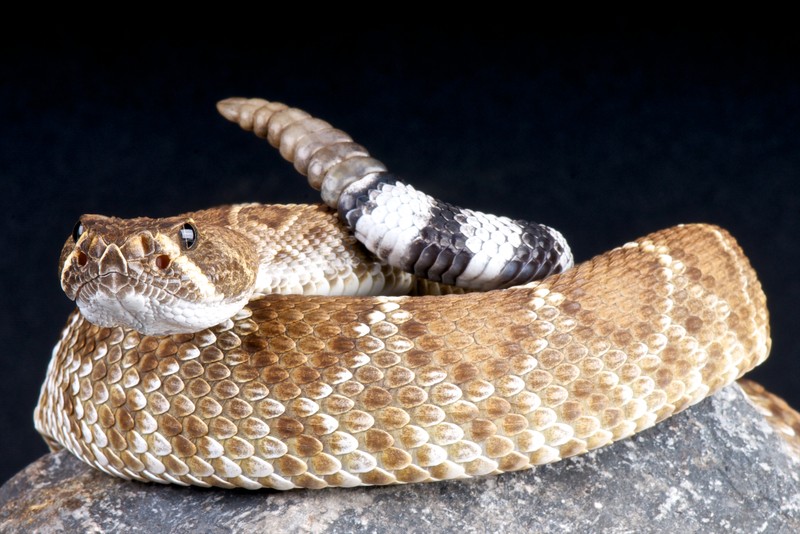A rattlesnake really doesn't want to bite you. The problem is that they don't have any other defense; no claws to lash out with and they can't turn tail and run because they don't move very quickly. All they have is their bite, which they would much rather use on their prey.
In rare instances, they have to choose going hungry over being trampled. Here are some characteristics of this pit viper so that you can prevent this from happening.
Rattle and hiss
Residents of the Southwestern United States likely have heard the distinctive buzz of these pit vipers. Their namesake rattle is a highly effective warning sign, signaling predators to stay away. “Rattles are segments of keratin that fit loosely inside one another at the end of the snake’s tail,” explained Sara Viernum, a herpetologist based in Madison, Wisconsin. “These segments knock against each other to produce a buzzing sound when the snake holds its tail vertically and vibrates the rattle. Each time a rattlesnake sheds its skin it adds another segment to the rattle.”
Rattlesnakes also hiss, a second element of its warning posture that is often overlooked and overshadowed by its rattle, writes Laurence Monroe Klauber in “Rattlesnakes: Their Habits, Life Histories, and Influence on Mankind” (University of California Press, 1997).
Characteristics
“Distinctive physical characteristics include producing venom, heat-sensing facial pits, hinged fangs and live births,” said Viernum. “These characteristics are shared with other pit vipers such as the cottonmouth and copperhead.” After the rattle, rattlesnakes’ most distinctive physical feature is their triangular head. Also, they have vertical pupils, like cat’s eyes.
Young rattlesnakes do not yet have their rattles, though they are as dangerous as adults, according to the National Park Service at Yosemite. Furthermore, some adults may lose their rattles, so it is a good idea look out for the triangular head.
Habitat
These adaptable serpents can thrive in a variety of environments. They are most abundant in the desert sands of the Southwest, but they also like grasslands, scrub brush and rocky hills. They can be found in the swamplands of the Southeastern United States and in the meadows of the Northeast. These snakes can handle high elevation and are found everywhere from sea level to 11,000 feet (3,353 m), according to the San Diego Zoo.
Habits
Rattlesnakes spend some time in dens, which they make in rocky crevices. Those in colder climates hibernate there for the winter. According to the South Dakota Game, Fish, and Parks Department, generation after generation of rattlesnake will use the same dens. The San Diego Zoo reported that they sometimes use the same den for more than 100 years. Upon leaving their dens, they like to sun themselves on rocks and other open places. Though they are not nocturnal, in the hot summer months they may be more active at night.
In addition to rattling and hissing, rattlesnakes exhibit other defensive behaviors. “They may also coil their bodies and raise their heads high off the ground in a defensive posture,” said Viernum. “This coiled position serves as a way to anchor the body if they body if they feel the need to strike with their raised head.
Diet
Rattlesnakes’ favorite foods are small rodents and lizards. They lie in wait until a victim comes along, and then strike at speeds of five-tenths of a second, according to the San Diego Zoo. Their venom paralyzes the prey, which they then swallow whole.
Bite
Their venom is extremely potent. “The venom of most rattlesnake species is composed mainly of hemotoxins,” Viernum said. “Symptoms include temporary and/or permanent tissue and muscle damage, loss of an extremity depending on the location of the bite, internal bleeding, and extreme pain around the injection area.”
Being bitten by a rattlesnake sucks, but it's 100% avoidable in nearly every circumstance. Rattlesnakes camouflage themselves so that their prey will come closer, but that telltale rattle exists to let larger animals, like us, know that we're about to step on them.
If a snake is too young for a rattle or has lost it, they are still going to shake their tail as if they have one. What you can take away from this is, essentially: be aware of your surroundings, don't stick your hands under rocks or logs, and don't handle any snakes if you aren't positive as to their species.
Follow these tips, and chances are you won't have to go to the hospital and explain why you have a snake attached to your face.
This is helpful information for anyone entering snake country. For more information like this, go to Live Science.

Thanks Marty….good to know!
Should be interesting, we are moving into the Mountains of Montana in June. What kind of boot should be worn?
c**n tail rattler
My uncle was a farmer and he had lost a leg due to diabetes. When he would work in the hay mow, he threw his wooden leg over first. If he felt a bump, (copperheads were his main opposition) he would lift his leg and grab the snake at the base of the skull and snap it. Biting into wood, the snake couldn’t pull itself free.
Fact #1:. Stay the hell away from venomous rattlesnakes. Fact #2. See fact #1.
Good information,thank you for posting.